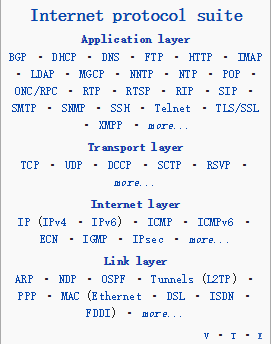The Link Layer Discovery Protocol (LLDP) is a vendor-neutral link layer protocol in the Internet Protocol Suite used by network devices for advertising their identity, capabilities, and neighbors on an IEEE 802local area network, principally wired Ethernet.[1] The protocol is formally referred to by the IEEE as Station and Media Access Control Connectivity Discovery specified in IEEE 802.1AB[2] and IEEE 802.3-2012 section 6 clause 79.
LLDP performs functions similar to several proprietary protocols, such as Cisco Discovery Protocol, Foundry Discovery Protocol, Nortel Discovery Protocol and Link Layer Topology Discovery.
Contents
[hide]
- 1Information gathered
- 2Applications
- 3Frame structure
- 4Media endpoint discovery extension
- 5See also
- 6Notes
- 7References
- 8External links
Information gathered[edit]
Information gathered with LLDP is stored in the device as a management information database (MIB) and can be queried with the Simple Network Management Protocol (SNMP) as specified in RFC 2922. The topology of an LLDP-enabled network can be discovered by crawling the hosts and querying this database. Information that may be retrieved include:
- System name and description
- Port name and description
- VLAN name
- IP management address
- System capabilities (switching, routing, etc.)
- MAC/PHY information
- MDI power
- Link aggregation
Applications[edit]
The Link Layer Discovery Protocol may be used as a component in network management and monitoring applications. One such example is its use in data center bridging requirements.[3]
The Data Center Bridging Capabilities Exchange Protocol (DCBX) is a discovery and capability exchange protocol that is used for conveying capabilities and configuration of the above features between neighbors to ensure consistent configuration across the network.[4]
Frame structure[edit]
LLDP information is sent by devices from each of their interfaces at a fixed interval, in the form of an Ethernet frame. Each frame contains one LLDP Data Unit (LLDPDU). Each LLDPDU is a sequence of type-length-value (TLV) structures.
The Ethernet frame used in LLDP has its destination MAC address typically set to a special multicast address that 802.1D-compliant bridges do not forward.[note 1] Other multicast and unicast destination addresses are permitted. The EtherType field is set to 0x88cc.
Each LLDP frame starts with the following mandatory TLVs: Chassis ID, Port ID, and Time-to-Live. The mandatory TLVs are followed by any number of optional TLVs. The frame ends with a special TLV, named end of LLDPDU in which both the type and length fields are 0.
Accordingly, an Ethernet frame containing an LLDPDU has the following structure:
LLDP Ethernet frame structure
| Preamble | Destination MAC | Source MAC | Ethertype | Chassis ID TLV | Port ID TLV | Time to live TLV | Optional TLVs | End of LLDPDU TLV | Frame check sequence |
|---|---|---|---|---|---|---|---|---|---|
| 01:80:c2:00:00:0e, or 01:80:c2:00:00:03, or 01:80:c2:00:00:00 |
Station's address | 0x88CC | Type=1 | Type=2 | Type=3 | Zero or more complete TLVs | Type=0, Length=0 |
Each of the TLV components has the following basic structure:
TLV structure
| Type | Length | Value |
|---|---|---|
| 7 bits | 9 bits | 0-511 octets |
Custom TLVs[note 2] are supported via a TLV type 127. The value of a custom TLV starts with a 24-bit organizationally unique identifier and a 1 byte organizationally specific subtype followed by data. The basic format for an organizationally specific TLV is shown below:
Organizationally specific TLV
| Type | Length | Organizationally unique identifier (OUI) | Organizationally defined subtype | Organizationally defined information string |
|---|---|---|---|---|
| 7 bits—127 | 9 bits | 24 bits | 8 bits | 0-507 octets |
According to IEEE Std 802.1AB, §9.6.1.3, "The Organizationally Unique Identifier shall contain the organization's OUI as defined in IEEE Std 802-2001." Each organization is responsible for managing their subtypes.
Media endpoint discovery extension [edit]
Media Endpoint Discovery is an enhancement of LLDP, known as LLDP-MED, that provides the following facilities:
- Auto-discovery of LAN policies (such as VLAN, Layer 2 Priority and Differentiated services (Diffserv) settings) enabling plug and playnetworking.
- Device location discovery to allow creation of location databases and, in the case of Voice over Internet Protocol (VoIP), Enhanced 911 services.
- Extended and automated power management of Power over Ethernet (PoE) end points.
- Inventory management, allowing network administrators to track their network devices, and determine their characteristics (manufacturer, software and hardware versions, serial or asset number).
The LLDP-MED protocol extension was formally approved and published as the standard ANSI/TIA-1057 by the Telecommunications Industry Association(TIA) in April 2006.[5]
See also[edit]
- OpenLLDP
- IEEE Get Program - download LLDP standards for free
Notes[edit]
- Jump up^ IEEE 802.1AB-2009 suggests three such addresses, 01:80:c2:00:00:0e, 01:80:c2:00:00:03 and 01:80:c2:00:00:00.
- Jump up^ Termed Organizationally Specific TLVs by IEEE 802.1AB
References[edit]
- Jump up^ "802.1AB-REV - Station and Media Access Control Connectivity Discovery". IEEE. Retrieved 2009-10-17.
- Jump up^ "IEEE standard 802.1AB-2009" (PDF).
- Jump up^ "Data Center Bridging Task Group". Retrieved 2012-03-10.
- Jump up^ Qlogic; et al. "DCB Capabilities Exchange Protocol Base Specification, Rev 1.01" (PDF). IEEE 802.
- Jump up^ "ANSI/TIA-1057 standard" (PDF).
External links[edit]
- Tutorial on LLDP
- IEEE standard 802.1AB document history
- The Wireshark Wiki LLDP Page
- LLDPD, Open Source LLDP Project
- lldpad, Open Source agent/daemon for Intel network connections
- ladvd, Open Source LLDP Project
- Comparison of LLDP daemons
- Computer networks
- Device discovery protocols
- Ethernet standards
- IEEE standards
- Link protocols
- Logical link control
- Network protocols
来源:oschina
链接:https://my.oschina.net/u/1864705/blog/798668
